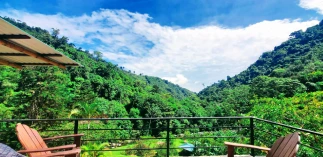Welcome back, birding enthusiasts, to another exciting encounter with the phenomenal feathered residents of Costa Rica! Today, we venture deep into the emerald embrace of our mountain rainforests to meet a secretive predator – the Bicolored Hawk (Accipiter bicolor).
This aptly named raptor lives up to its billing with a striking two-toned plumage. Adults are a study in cool grays, with a darker crown and upperparts that contrast beautifully with their light gray underparts. But wait, there’s more! A flash of rufous peeks from their thighs, often hidden from view, and their tail boasts two prominent pale bands.
While not the most common sight, the Bicolored Hawk holds the title of the most prevalent Accipiter species within its range. Stretching from southeastern Mexico down through Central America and into northern and central South America (reaching as far south as northern Argentina), these birds favor the verdant haven of forests, woodlands, second-growth areas, plantations, and wooded savannas.
Here at our Costa Rican mountain retreat, you have a good chance of encountering the Bicolored Hawk flitting through the dense foliage. Though generally shy, their hunting tactics can sometimes bring them out into the open. Unlike soaring hawks, the Bicolored Hawk prefers a surprise attack, using its agility to navigate the maze of branches and launch quick assaults on unsuspecting prey.
Speaking of prey, their diet consists mainly of small to medium-sized birds, lizards, frogs, and even insects. Their keen eyesight and sharp talons make them efficient hunters, a vital role in maintaining the balance of the rainforest ecosystem.
Identifying the Bicolored Hawk:
- Adults: Mostly gray with a darker head and upperparts, two pale tail bands, and rufous thighs (often hidden). Belly can have a rufous tinge with faint barring in the southern part of their range.
- Juveniles: Look surprisingly like a forest-falcon, but with a key difference – a yellow eye (falcons have brown eyes) and no dark crescent marking on their face.
Tips for Spotting the Bicolored Hawk:
- Keep an eye out for them perched on low branches or trunks, scanning for prey within the forest canopy.
- Listen for the calls of smaller birds, which might indicate the presence of a predator. Bicolored Hawks have a high-pitched, whistled call that can help you narrow down your search.
- Patience is key! Birding is all about appreciating the subtle movements and sounds of the forest.
With a bit of perseverance and a keen eye, you might just catch a glimpse of this elusive yet magnificent avian predator. The Bicolored Hawk is a testament to the hidden wonders that lurk within the lush embrace of the Costa Rican mountains. So, stay tuned for our next birding adventure, where we’ll unveil another feathered gem waiting to be discovered!
For more information, please view our comprehensive guide about the birds of Costa Rica







